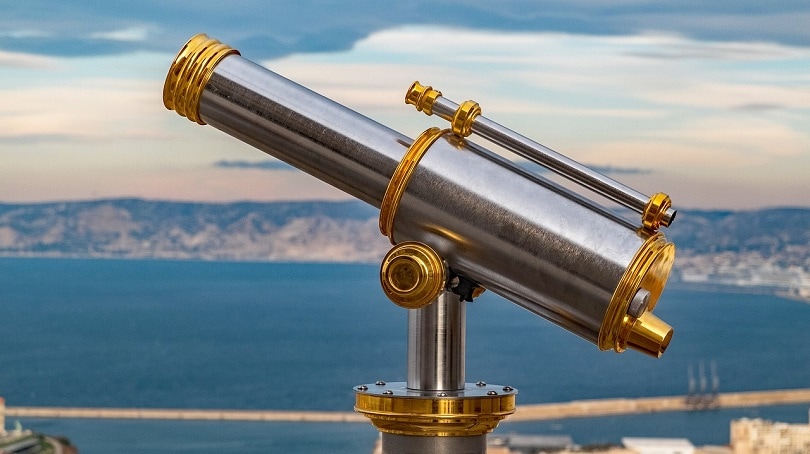Who Invented the Telescope & When? A Brief History
Last Updated on

Before the 1600s, humanity exclusively looked at the world through our own two eyes and could only see as far our eyes could take us. But when the telescope burst onto the scene, a whole new world opened up, allowing humanity to observe stars and worlds never seen before.
But who first invented this groundbreaking mechanism, and when did they open up this new world for visual exploration? We’ll break it all down here, leaving you an expert in the early world of telescopes.

Four Names to Know
While there are plenty of twists, turns, and names worthy of recognition, there are four names that stick out above the rest when it comes to the world of early telescopes. We’ll break them all down here and their contributions to the telescope.
1. Hans Lippershey
Hans Lippershey was the first person to patent a telescope in 1608. While he got plenty of acclaim during his lifetime for his achievement, he’s one of today’s lesser-known figures.
While it’s not surprising since his invention was dwarfed by those of Galileo Galilei just one year later, Lippershey inspired Galileo, and to have Lippershey’s place in history overshadowed by Galileo is a bit disappointing.
Lippershey’s telescope could provide up to 3x magnification, which marked a resounding improvement on unaided vision. As a result, Lippershey received commissions to build his telescopes for many high-class individuals around Europe, including King Henry IV of France.
2. Galileo Galilei
When Galileo heard of Lippershey’s telescope, he immediately set to work on building his own. He never saw Lippershey’s telescope, and perhaps that’s a blessing. Because in the end, Galileo built a telescope that couple provided a maximum of 20x magnification in 1609.
But Galileo’s accomplishments go beyond just making an amazing telescope for the first time. He’s also credited as the first individual to point his telescopes at the stars.
This is an amazing feat because anyone who’s ever looked at the sky with a telescope knows that this unlocks a whole new world. Galileo used his telescope to draw the Milky Way and craters of the moon.
He discovered Saturn’s rings and four of Jupiter’s moons. Using his observations, he confirmed his belief in Copernicus’s Heliocentric view of the solar system.
3. Johannes Kepler
In the world of telescopes, everything moved lightning-quick after Lippershey first applied for a patent in 1608. In 1609 Galileo improved the design, and by 1611 Johannes Kepler improved it further.
Kepler’s main contribution is that he replaced the concave lens with convex lenses. It might not sound like much, but it allowed for a wider field of view, better eye relief, and much better magnification rates.
Kepler’s design was so transformative that the main design changes improved upon the Keplerian Telescope until 1668.
The refractive Keplerian Telescope improved the field of telescopes in many ways, but one of the side effects of the concave lenses was that it inverted the image. Refractive telescopes are still in widespread use today, but top models have moved to the reflective design that Newton invented 57 years later.
4. Isaac Newton
Before Isaac Newton, every telescope worked off the same principle – refraction. While both compound and refracting telescopes existed, neither utilized mirrors instead of lenses. This was an idea that astronomers and scientists talked about for some time, but nobody actually built it before Newton.
When Newton finished his reflecting telescope in 1668, it revolutionized the telescope world. For starters, reflecting telescopes were much cheaper to build, easier to assemble, and gave a wide field of view.
But those advantages paled in comparison to the next two features. First, reflecting telescopes were much smaller than refracting telescopes, making them much more portable. If you were trying to avoid light pollution or take a telescope anywhere outside of the lab, this was a significant advantage.
Second, it removed the aberration issues that plagued refracting telescopes. Refracting telescopes would place red light and blue light in different positions, leading to an image that didn’t necessarily match reality. The Newtonian Reflecting Telescope took care of this issue.
Conclusion
While there have been more modern advances to the telescope, the ones that amateur astronomers use are still reminiscent of these early inventions.
They opened humanity to an entirely new world in the cosmos, and as these telescopes have shrunk, we’ve turned many of them back towards the surface to watch birds and other forms of wildlife.
The invention of the telescope truly revolutionized the way we see the world and our place in it. While you might feel that there’s not much to look forward to – we’re still deploying improved versions of these modern marvels to better our understanding of the universe.
Before you go… check out some of our other top-trending posts:
- 6 Types of Bird Feathers (with Pictures)
- 10 Best Telescopes for Kids – Reviews & Top Picks
- 4 Types Of Blue Bird Species In the US (with Pictures)
Featured Image Credit: djedj, Pixabay
About the Author Robert Sparks
Robert’s obsession with all things optical started early in life, when his optician father would bring home prototypes for Robert to play with. Nowadays, Robert is dedicated to helping others find the right optics for their needs. His hobbies include astronomy, astrophysics, and model building. Originally from Newark, NJ, he resides in Santa Fe, New Mexico, where the nighttime skies are filled with glittering stars.
Related Articles:
Binocular Magnification Chart: Numbers & Distances Compared
How to Clean a Refractor Telescope: Step-by-Step Guide
How to Clean a Telescope Eyepiece: Step-by-Step Guide
When Were Binoculars Invented? History, Today & Future
Monocular vs Telescope: Differences Explained (With Pictures)
How to Clean a Rifle Scope: 8 Expert Tips
What Is a Monocular Used For? 8 Common Functions
How to Clean a Telescope Mirror: 8 Expert Tips
